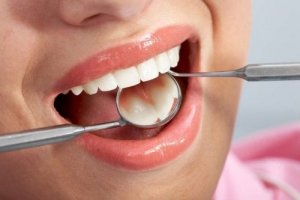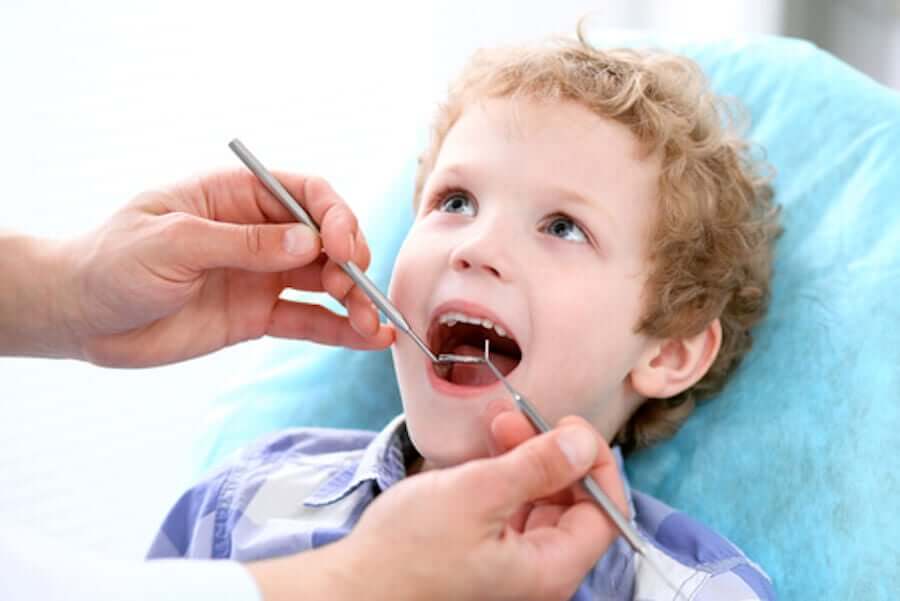How to Prevent Tooth Decay with Fluoride

Tooth decay is one of the major health problems that affect children nowadays. This is due to the consumption of sweets and sugars, as well as the lack of knowledge about dental care. In this article, we’ll tell you how to prevent tooth decay with fluoride at any age.
Tooth decay: A recurring problem
Tooth decay is increasingly manifesting at younger ages. Although it causes “holes” in teeth that may seem harmless, they’re actually not. If left untreated, they result in discomfort, pain, expensive treatments, and, in severe cases, tooth loss.
Tooth decay develops when foods rich in sugars and carbohydrates become “trapped” between the teeth.
The main foods that increase the likelihood of tooth decay are sweets, such as pastries and ice cream, as well as those prepared with flour, such as pizza, bread, and pasta.

It’s important for children to follow a daily dental hygiene routine to avoid tooth decay.
When oral bacteria feed on waste, they eject an acid that slowly deteriorates tooth enamel. In addition to the increased consumption of foods that cause tooth decay, it’s essential to mention a very important factor: inadequate oral hygiene.
Thus, you should brush your teeth at least three times a day. Since we’re children, we should learn how to clean our mouth using a toothbrush, toothpaste, floss, and mouthwash.
Can I prevent tooth decay with fluoride?
More and more dentists are telling their patients to prevent tooth decay with fluoride. Although this mineral has the ability to strengthen tooth enamel, it must be used properly. Some doctors may also indicate the consumption of fluoride drops or tablets if the patient is very prone to tooth decay, even if they follow an adequate oral hygiene routine.
The local effect of fluoride applied directly to the teeth and molars can prevent the onset of this common dental problem. Mouthwashes are also another source of fluoride. However, they aren’t always recommended in children because they may contain alcohol.
Fluoride for children
Regarding children, some are very prone to tooth decay, which is why dentists indicate fluoride treatments for these patients. Some examples of these cases are children with:
- Active tooth decay.
- Fixed orthodontic appliances.
- Mouth malformations.
- Disabilities that don’t allow them to brush their teeth well.
- Serious illnesses such as hemophilia or heart or immunity problems.

In these cases, the dentist may indicate special treatments with fluoride coatings or gels that they place over the teeth as if they were a paste or cream. This can be quite effective, even more so if the fluoride is ingested in water and reaches the teeth through the blood of the gums.
Be careful with the doses
It’s necessary to be careful with the fluoride doses, as too much of it can be counterproductive and even stain teeth or damage tooth enamel. Children up to the age of six should only use the fluoride included in children’s toothpaste. After that age, they can use adult toothpaste, although in smaller quantities.
Beyond the amount of fluoride any toothpaste contains, the truth is that the best way to prevent tooth decay is through regular brushing. If you’re not sure how to properly brush your teeth and mouth, you should consult your dentist.
And it’s even more important for your children to see you brushing your teeth. Don’t forget that you’re their role model!
Tooth decay is one of the major health problems that affect children nowadays. This is due to the consumption of sweets and sugars, as well as the lack of knowledge about dental care. In this article, we’ll tell you how to prevent tooth decay with fluoride at any age.
Tooth decay: A recurring problem
Tooth decay is increasingly manifesting at younger ages. Although it causes “holes” in teeth that may seem harmless, they’re actually not. If left untreated, they result in discomfort, pain, expensive treatments, and, in severe cases, tooth loss.
Tooth decay develops when foods rich in sugars and carbohydrates become “trapped” between the teeth.
The main foods that increase the likelihood of tooth decay are sweets, such as pastries and ice cream, as well as those prepared with flour, such as pizza, bread, and pasta.

It’s important for children to follow a daily dental hygiene routine to avoid tooth decay.
When oral bacteria feed on waste, they eject an acid that slowly deteriorates tooth enamel. In addition to the increased consumption of foods that cause tooth decay, it’s essential to mention a very important factor: inadequate oral hygiene.
Thus, you should brush your teeth at least three times a day. Since we’re children, we should learn how to clean our mouth using a toothbrush, toothpaste, floss, and mouthwash.
Can I prevent tooth decay with fluoride?
More and more dentists are telling their patients to prevent tooth decay with fluoride. Although this mineral has the ability to strengthen tooth enamel, it must be used properly. Some doctors may also indicate the consumption of fluoride drops or tablets if the patient is very prone to tooth decay, even if they follow an adequate oral hygiene routine.
The local effect of fluoride applied directly to the teeth and molars can prevent the onset of this common dental problem. Mouthwashes are also another source of fluoride. However, they aren’t always recommended in children because they may contain alcohol.
Fluoride for children
Regarding children, some are very prone to tooth decay, which is why dentists indicate fluoride treatments for these patients. Some examples of these cases are children with:
- Active tooth decay.
- Fixed orthodontic appliances.
- Mouth malformations.
- Disabilities that don’t allow them to brush their teeth well.
- Serious illnesses such as hemophilia or heart or immunity problems.

In these cases, the dentist may indicate special treatments with fluoride coatings or gels that they place over the teeth as if they were a paste or cream. This can be quite effective, even more so if the fluoride is ingested in water and reaches the teeth through the blood of the gums.
Be careful with the doses
It’s necessary to be careful with the fluoride doses, as too much of it can be counterproductive and even stain teeth or damage tooth enamel. Children up to the age of six should only use the fluoride included in children’s toothpaste. After that age, they can use adult toothpaste, although in smaller quantities.
Beyond the amount of fluoride any toothpaste contains, the truth is that the best way to prevent tooth decay is through regular brushing. If you’re not sure how to properly brush your teeth and mouth, you should consult your dentist.
And it’s even more important for your children to see you brushing your teeth. Don’t forget that you’re their role model!
All cited sources were thoroughly reviewed by our team to ensure their quality, reliability, currency, and validity. The bibliography of this article was considered reliable and of academic or scientific accuracy.
- Palma, C., Cahuana, A., & Gómez, L. (2010). Guía de orientación para la salud bucal en los primeros años de vida. Acta Pediatrica Espanola. https://doi.org/10.1016/j.cageo.2010.06.009
This text is provided for informational purposes only and does not replace consultation with a professional. If in doubt, consult your specialist.








